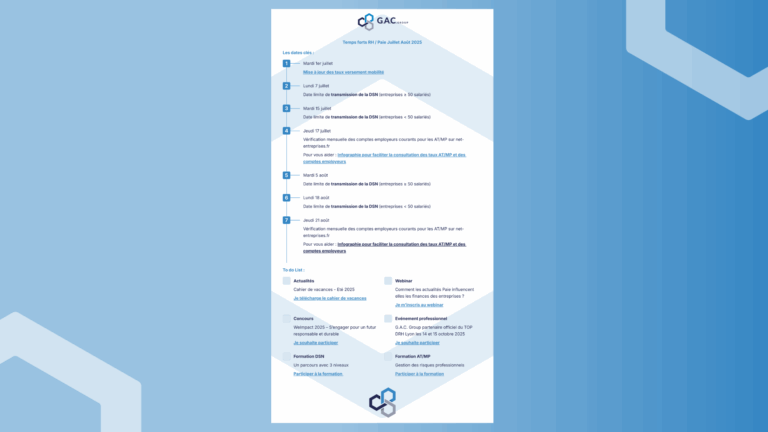The phenomenon of absenteeism is multifactorial in both its internal and external impacts. It is also multifactorial in its causes (origins) and intentions (desired goals).
Even if the figures show that certain factors, such as sector of activity, have an impact on absenteeism rates, it is probably less the sector of activity than the nature of the work performed and the conditions under which it is carried out that are involved in this correlation.
As a result, the absenteeism rate is a synthetic indicator that condenses different physical and psychosocial factors that interact with each other.
Shared responsibilities: management, managerial line, employees and staff representatives
Leaders and management
The first of the missions of a management is not to consider his absenteeism as inevitable (in his sector of activity, in his company, in a department…). If nothing is done, absenteeism can only deteriorate: if it exists, it is because there are reasons!
Addressing these reasons requires managerial courage and often to better confront the realities of work situations.
This is why taking action to better control absenteeism requires, like any strategic project, support at the highest level of the company or organization so that the entire managerial line is mobilized.
The role of management is decisive in challenging the project on political, temporal, ethical and strategic dimensions.
However, management alone is not enough. Understanding the characteristics and manifestations of absenteeism - therefore as close as possible to the field - can only allow effective and long-term action on the mechanisms that lead employees to be absent. Absenteeism is therefore also the concern of everyone, employees and their representatives.
Staff representatives
Employee representative bodies are an ideal forum for raising and discussing the subject internally. Absenteeism is in fact a cross-functional theme which can provide useful input for institutional social dialogue. In particular, it is important to consider from the outset the link with staff representative bodies when planning the project.
The staff representative is useful for challenging the project on social and political dimensions.
However, it should not replace or obscure the direct involvement of employees, who are the only ones to know the constraints and resources of the conditions for carrying out their work, where everything is played out.
The collaborators
If the solutions were obvious and simple, the problems of absenteeism would have been resolved a long time ago and would no longer be talked about.
There is not THE solution, the one that would be unique and meet all the criteria. There is a solution to be found collectively among several possible.
It emerges from internal debates between the various stakeholders, first and foremost the employees directly concerned by the causes and reasons for absenteeism.
The role of employees is major in challenging the project on organizational, human, social and operational dimensions.
The influence of the conditions of performance of the work
Well-being at work: general diagram of a systemic
The metaphor of the iceberg is often used to represent absenteeism as its emergent form, visible to all. The cost of absenteeism may not be directly visible in the reporting tables or the financial accounts of the company, but they are very real.
We find them in the increase in ancillary personnel costs, in production cuts or in sales decreases following the loss of customers unhappy with a drop in quality or an extension of deadlines, in the 'increase in rejection rates,… all of them are induced effects of absenteeism.

Absenteeism, the tip of the iceberg, is the consequence of underlying causes relating to the conditions in which work is performed.
The goals sought may be, for example, to avoid being confronted again with conditions deemed harmful to one's physical and / or mental health: a conflict with one's superiors or a colleague, the feeling of not succeeding, of not to recognize…
The seven disengagement factors at work that fuel absenteeism
The categorization of the conditions for carrying out the work varies according to the authors, some retain four, the national inter-professional agreement (ANI) on the quality of life at work of June 19, 2013 retains ten, the report of the Gollac expert committee on psychosocial risks identifies six ...
Factors of a psychosocial nature are decisive in the process which leads employees to take time off and disengage. Also, we rely on the results of the college of expertise by isolating the work environment factor as a seventh condition for carrying out work in its own right.
We detail below how these seven working conditions can act as a factor in employee disengagement. It should be noted that these conditions most often act in combination with several of them and are also possibly different from one employee to another.
Work intensity and working time
This category includes the conditions for carrying out the work which concern the intensification of the work (henceforth doing in two what was until now done by three people, being responsible for more projects with fewer resources or without additional resources, etc.), the "load" of work, the pace of work, the balance between working and non-working time, the organization of work, the increasing complexity of tasks, the realism of objectives, etc.
Each of these dimensions is likely to create disengagement on the part of the employee: the perception of not being able to achieve it, of feeling overwhelmed, of being forced to do work "neither done nor done" ...
Emotional demands
This category brings together the conditions for carrying out the work which put in contact with the public and especially the dissatisfied public (reception, maintenance, after-sales service, call centers, etc.) and / or human suffering (universe of health, dependency, social) or animal (laboratories, slaughterhouses, etc.).
It also includes the conditions where you have to mask your emotions and / or which confront employees with a feeling of fear. These risk factors, historically present in the service sector, now extend to all sectors and in particular to industry with the so-called “servicialization” of the economy where the client / user also becomes a co-producer of the service.
These factors are all likely to create disengagement on the part of the employee due to the extreme personal involvement of the employee involved.
Autonomy and versatility
At a time when the agile company is becoming more and more obvious, autonomy (having decision-making latitude, having the choice in how to proceed) is often valued as a vector of employee motivation, employee involvement and commitment. However, too much autonomy in which the employee is more abandoned to himself to find solutions, make trade-offs that go beyond his perimeter of responsibility or compensate for areas of lawlessness in the organization is, on the other hand, more likely to generate disengagement.
The question of autonomy also raises the question of qualification and more specifically that of skills: having a job that does not allow you to develop your skills, enrich your knowledge or deploy new know-how is more likely to generate of disengagement. Versatility is also a factor that has traditionally aimed at enriching positions. But conversely, a tendency towards too much versatility can generate a loss of professional identity and the feeling of doing a bit of everything without acquiring or keeping "a real job", which is also likely to generate a problem of disengagement. .
The work environment
This category concentrates all the physical environments of work: having sufficient light, being in a comfortable sound environment, benefiting from materials and functional equipment adapted to its activity, to its morphology… The attention paid to the environment has a direct impact on employee health (heat, cold, night work, shift work, etc.).
These factors, added to other factors, in particular aspects of social relations at work, workload and recognition, can fuel employee disengagement.
Professional social relations
This category brings together two main types of factors that will offset each other or, on the contrary, create a multiplier effect:
- Relations between colleagues
If the employee does not feel involved in a team or if he considers that he cannot count on the support of his colleagues, that he must be wary of his colleagues ... this will generate tensions and competition within the same team and generate disengagement. Conversely, if he feels he belongs to a team, the working atmosphere will be conducive to cooperation, mutual aid and solidarity, vectors of performance.
- Relations with his hierarchy
Likewise, if the manager considers his mission to be mainly in the field of control or sanction or if he comes in support, by developing the skills and the confidence of his team, this will generate either frustration or promote a work dynamic conducive to creativity and initiative.
A lack of feedback from the manager, whether in terms of constructive criticism or positive appreciations, is experienced as a source of major frustrations for the employee.
The manager has an essential impact on the quality of relationships between colleagues within his team.
Value conflicts / the meaning of and at work
This category groups together the factors that lead employees to take actions or make statements that contradict their personal values (having to sell products that are unsuitable for their interlocutor's needs, having to stick to a script while being aware that this does not meet the customer's request, ...), to find no meaning in their work, to be unable to do a "job well done" (quality prevented) or to have the feeling of doing unnecessary tasks .
These elements which strongly involve the subjectivity of each individual are likely to quickly lead to phenomena of protection and disengagement on the part of employees.
The insecurity of the work situation
This category brings together all the elements that do not make the future of the employee serene (precarious employment contract, lack of prospects relating to his job, his profession, his career, his service, his company, ...) and / or which are generative strong concerns (announced or suspected changes, misunderstanding or non-visibility of the strategy followed, restructuring, etc.).
Employee disengagement, even if it is not immediately and directly visible, can be a consequence of communication that is not sufficiently focused internally on these different elements.
This is especially the case when the motivations at play in the changes are not clear enough to employees.
THE ESSENTIALS TO REMEMBER
The working conditions are essential in the process which leads an employee to be absent or to disengage: the intensity and the working time, the emotional demands, the lack or too much autonomy / versatility, an environment unsuitable work, degrading socio-professional relationships, disagreement over work values and insecurity of the work situation.
To act on absenteeism, it is essential that it become a COMMON object of concern between all the actors of the company: a support at the highest level of the company so that the entire managerial line is mobilized, the involvement of employees and staff representatives.
The final objective is to find a COLLECTIVELY compromise on the conditions for carrying out the work to be developed favorably.









